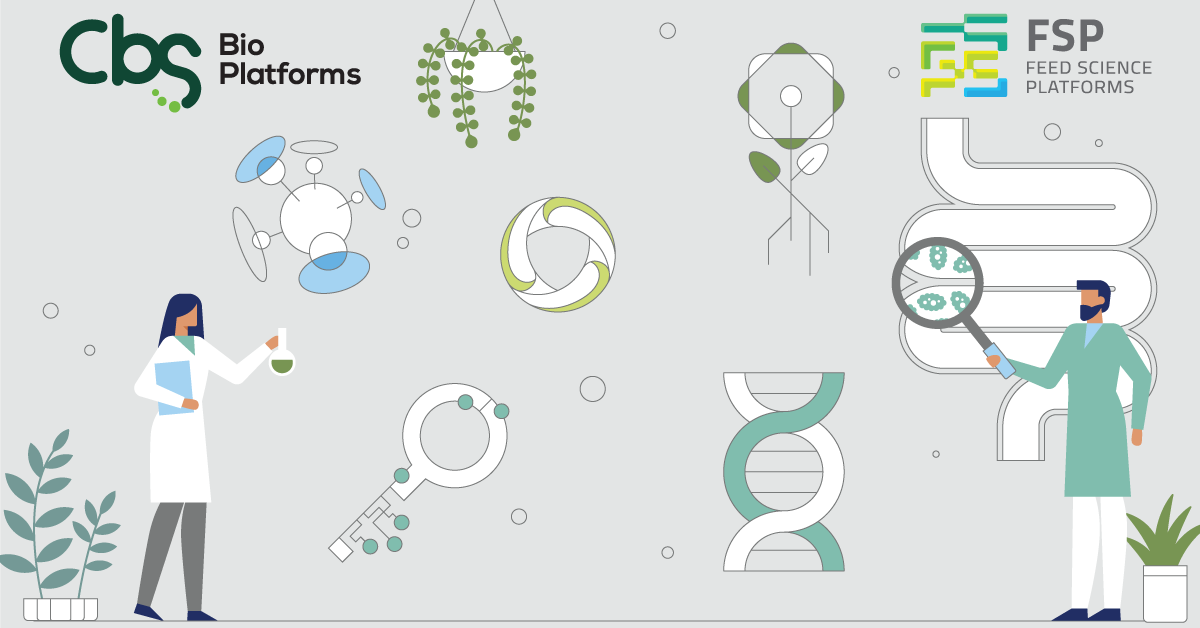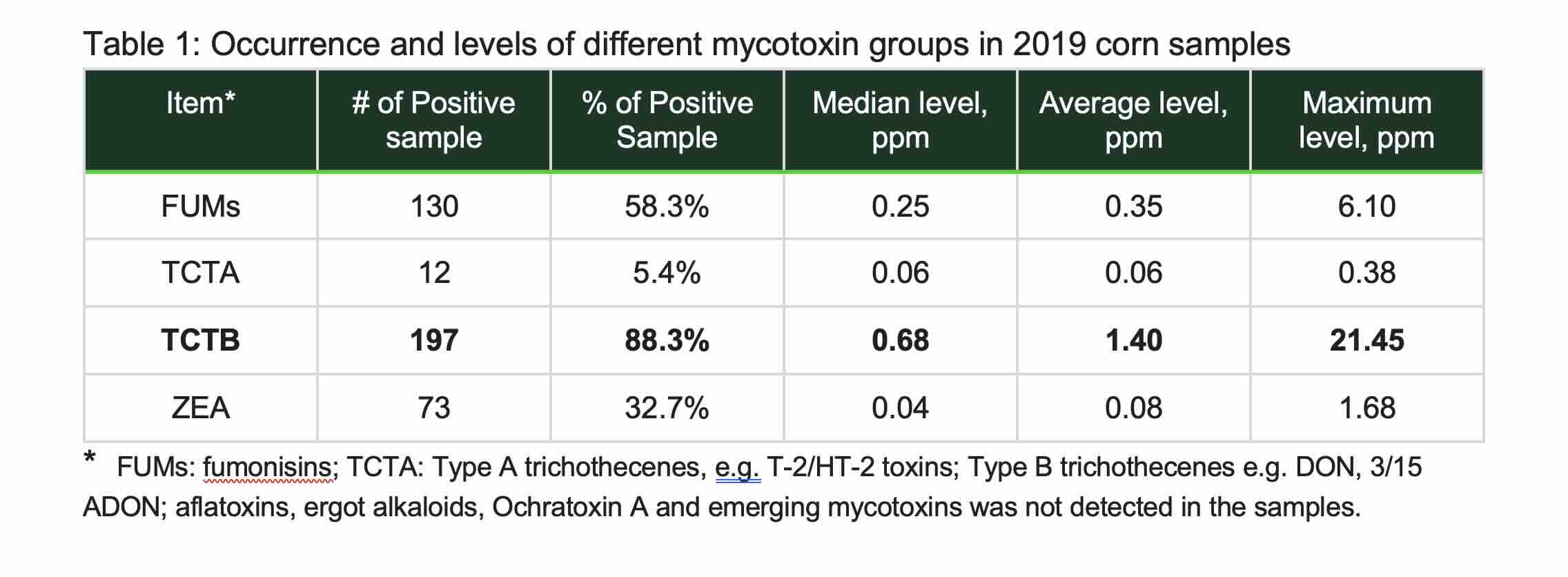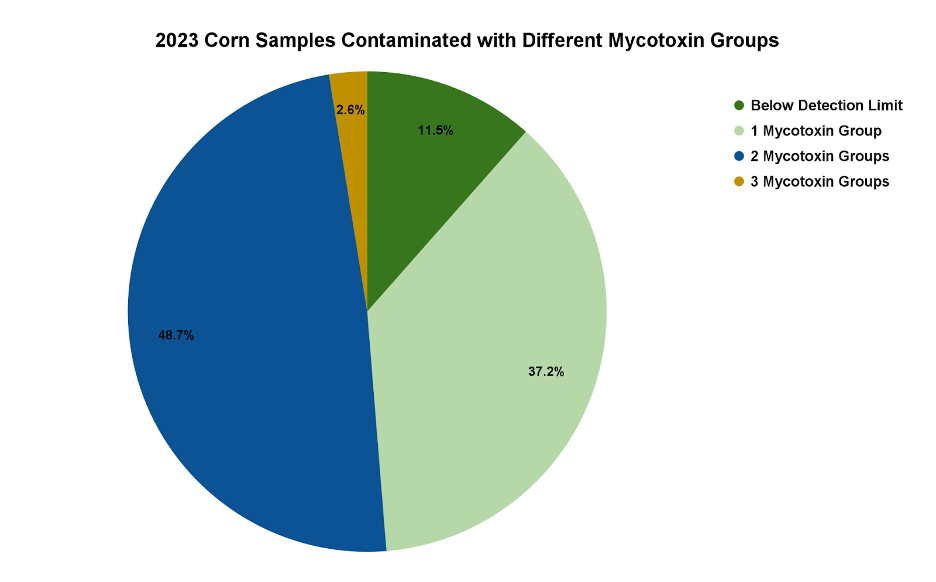Mycotoxins in Ontario corn: An old problem with new challenges
November 1, 2023



By Dr. Anhao (Tony) Wang, CBS Bio Platforms
In line with other ingredients, like soybean meal (SBM), corn prices have remained high since 2020. For the ON farmers who are expecting strong corn yields, this is good news.

However, as indicated in our recent article (Harvest Advisory: Plan Ahead to Safeguard Feed from Mycotoxins), with the late summer and fall rains and the delayed harvesting, the risk of mycotoxin contamination is also rising. This weather and harvesting condition may bring us to a similar situation we faced in the 2018/2019 harvesting year. During the 2018/2019 harvesting, we saw increases in the incidence of contamination and the toxin concentrations in the corn samples.
Minimizing the risks of mycotoxin contamination is one of the main focuses of CBS Bio Platforms. As part of our Grain Management technology, we analyze mycotoxin contamination in different ingredients and feed through our MycoCheck program. Those who are subscribed to the MycoCheck program submit samples to CBS, and in-return, receive a customized report outlining any potential mycotoxin exposure.
In the MycoCheck program, we analyzed 8 main groups of mycotoxins, namely aflatoxins (AFs), ergot alkaloids (EA), fumonisins (FUMs), Type A (e.g. T-2/HT-2 toxins) and B (e.g. DON, 3/15 ADON) trichothecenes (TCTA and TCTB, respectively), Ochratoxin A (OTA), zearalenone (ZEA), and emerging mycotoxins.
We can better prepare for the upcoming mycotoxin challenges by looking at some historical mycotoxin data in the corn from years with similar weather conditions, like 2018/2019.
In 2019, we analyzed 223 corn samples from various ON feed mills and farmers. Among those samples, 215 samples were contaminated with at least 1 group of mycotoxins. Most corn samples (81.2 % or 181 samples) were contaminated with 2 or more groups of mycotoxins. The most frequently detected mycotoxin group is TCTB (88.3% samples), and the highest concentration of DONs (DON+ADONs) is around 21.5 ppm (Table 1). Other frequently occurring mycotoxins are FUMs and ZEA (Table 1).


* FUMs: fumonisins; TCTA: Type A trichothecenes, e.g. T-2/HT-2 toxins; Type B trichothecenes e.g. DON, 3/15 ADON; aflatoxins, ergot alkaloids, Ochratoxin A and emerging mycotoxins was not detected in the samples.
In 2023, we analyzed 157 corn samples from the same region. 138 samples were contaminated with at least 1 group of mycotoxins. Among contaminated samples, 80 samples (51.3%) had 2 or more groups of mycotoxins. Similar to 2019, the most frequently detected mycotoxin group is TCTB (77.1% samples; Table 2). The highest concentration of DONs (DON+ADONs) is much lower than in 2019 (5.6 vs 21.5 ppm). It should be noted that the occurrence, maximum, average and median level of ZEA is higher than 2019 (43.3 vs. 32.7%; 2.41 vs. 1.68 ppm; 0.11 vs. 0.08 ppm and 0.05 vs. 0.04 ppm, respectively; Table 2). The occurrence of FUMs is lower than in 2019. Overall, the mycotoxin occurrences and levels in 2023 corn samples were lower than in 2019.
However, as fall rains delay harvesting, we would likely see unwelcome increases in the occurrence of mycotoxin contamination and higher levels of toxins in corn. Although it is not yet seen in corn samples, storage mycotoxins, like OTA, are more frequently detected. The increased occurrence and levels of OTA suggest that some grain may be subjected to sub-optimal drying and storage conditions. Some samples are contaminated with OTA at levels that may cause kidney (a vital organ that detoxifies and excretes dietary mycotoxins) damage in young animals (0.2 ppm; CFIA, RG-8). The co-occurrence of storage mycotoxins like OTA may amplify the toxic effects of field Fusarium mycotoxins.


* FUMs: fumonisins; TCTA: Type A trichothecenes, e.g. T-2/HT-2 toxins; Type B trichothecenes e.g. DON, 3/15 ADON; aflatoxins, ergot alkaloids, Ochratoxin A and emerging mycotoxins was not detected in the samples.
In addition to the MycoCheck program, CBS offers diverse mycotoxin mitigation solutions such as NutraMix™, a feed enhancer that supports safe, high-quality feed and animal benefits, and CBS Yeast Bioactives technology like Maxi-Nutrio that can improve animal health, immunity, and performance. Combining Grain Management and Yeast Bioactives technologies can provide a more comprehensive safeguard against potential mycotoxin challenges we may face in later 2023 and 2024.

